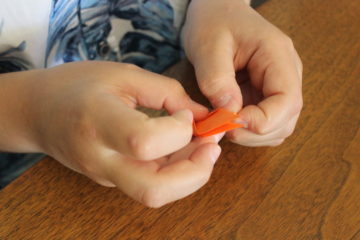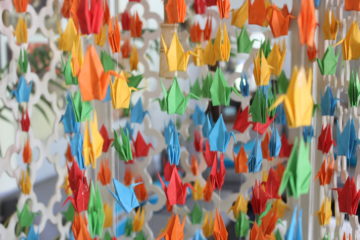By DAVID DUPONT
BG Independent News
Paper cranes cannot fly.
Still some 400 origami cranes, folded with care by 12-year-old Daniel Schuman of Bowling Green, will take flight this week and return to their traditional home in Japan.
Akiko Jones, the director of the Asian Studies Program at Bowling Green State University, will bring the cranes over with her when she travels there with students. She will place them at the Peace Memorial at Hiroshima, under the gaze of the statue of Sadako Sasaki.
It was Sadako’s story, told in a book “Sadako and the 1,000 Cranes” that revived an ancient Japanese legend.
 Daniel wrote in his PACE reoirt that the legend maintained: “Anyone with the patience and commitment to make 1,000 cranes will make their one desired wish come true.”
Daniel wrote in his PACE reoirt that the legend maintained: “Anyone with the patience and commitment to make 1,000 cranes will make their one desired wish come true.”
Sadako was a young victim of the atomic bomb attack on Hiroshima. She suffered from leukemia, and in her last days she began folding cranes. After she died and her story traveled around the world, others emulated her dedication.
This is one of the many aspects of origami that 12-year-old Daniel discovered while doing a project on the craft for PACE, the Bowling Green program for gifted students.
Daniel, the son of Gloria Gajewicz and stepfather Chris Gajewicz and Andrew Schuman, first got interested in origami at BGSU’s Cherry Blossom Festival, organized by Jones and staged by the Japanese Club.
He was intrigued by the intricacies of the paper folding. Someone had already thought he might have an interest in the craft because he had a couple origami books that he’d received as gifts.
 His interest piqued, he delved into the craft. He makes gift boxes, chicks for Easter, and little pigs for Thanksgiving. He’s grow his own garden of paper flowers. And cranes.
His interest piqued, he delved into the craft. He makes gift boxes, chicks for Easter, and little pigs for Thanksgiving. He’s grow his own garden of paper flowers. And cranes.
His mother was talking with Jones during a reception on campus and Gajewicz mentioned that her son was doing origami.
Jones offered to bring some of Daniel’s cranes to Hirsoshima.
Jones, a native of Japan, travels back every summer bringing students from the university’s Asian Studies and Peace Studies programs.
These always involve a stop at the Peace Memorial.
Bringing origami cranes is a tradition. When President Barack Obama visited he brought four cranes he had folded. Two to be displayed and one each given to a Japanese boy and girl who were there to greet him.
Now Daniel’s cranes, 100 times more than those four, will take their place in the display.
And he has no intention of stopping. Through his PACE project he learned of origami pioneers Akira Woshizawa and Robert Lang.
They developed new techniques and new models, he explained. The late Woshizawa is considered the grandmaster of origami who elevated origami to an art form.
Lang is still active and innovating. He’s developed a program that uses 3D modeling to allow people to create folding patterns.
Origami with its intricate geometry has been used to develop air bags and a telescope, Daniel said.
For his part, Daniel would like to be able to look at am object and be able to figure out how to fold it.
Going in seventh grade, Daniel plays trombone – he was attracted by the instrument’s slide. He also plays soccer with the Bowling Green Soccer Club.
And he’s already set his sights on college. He’d like to attend MIT. Origami’s spatial relationship lessons should serve him well.

